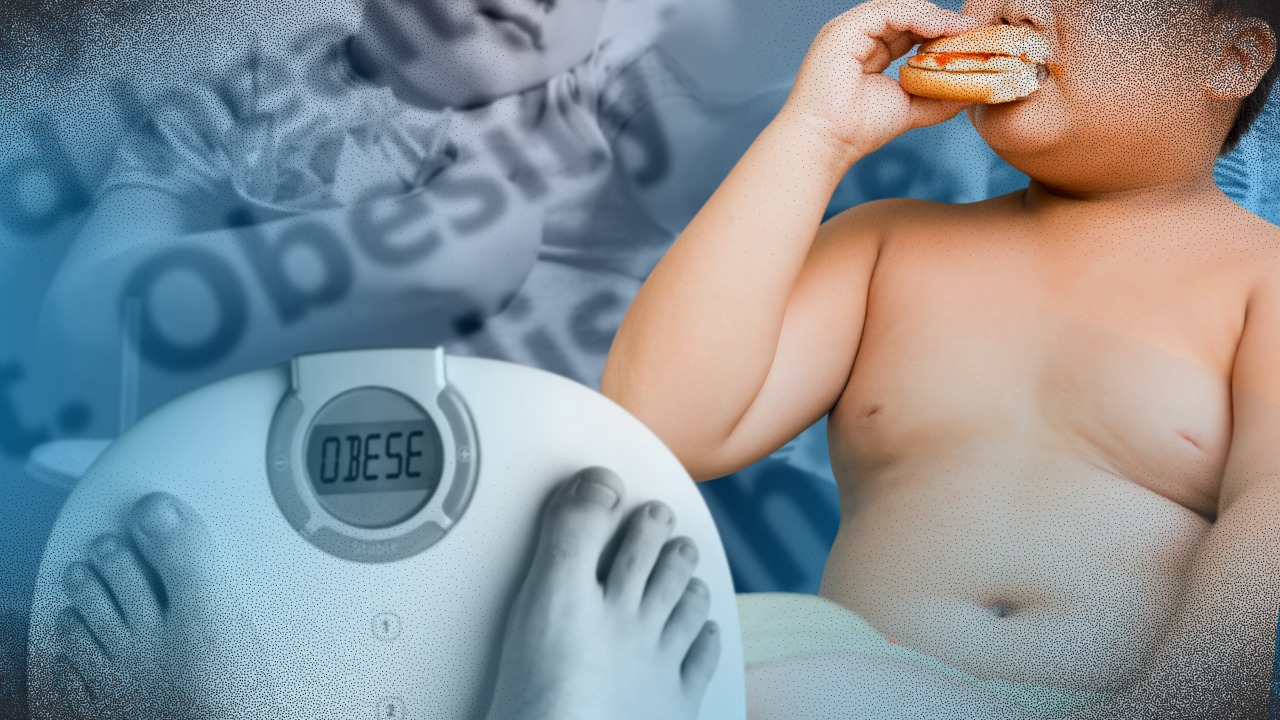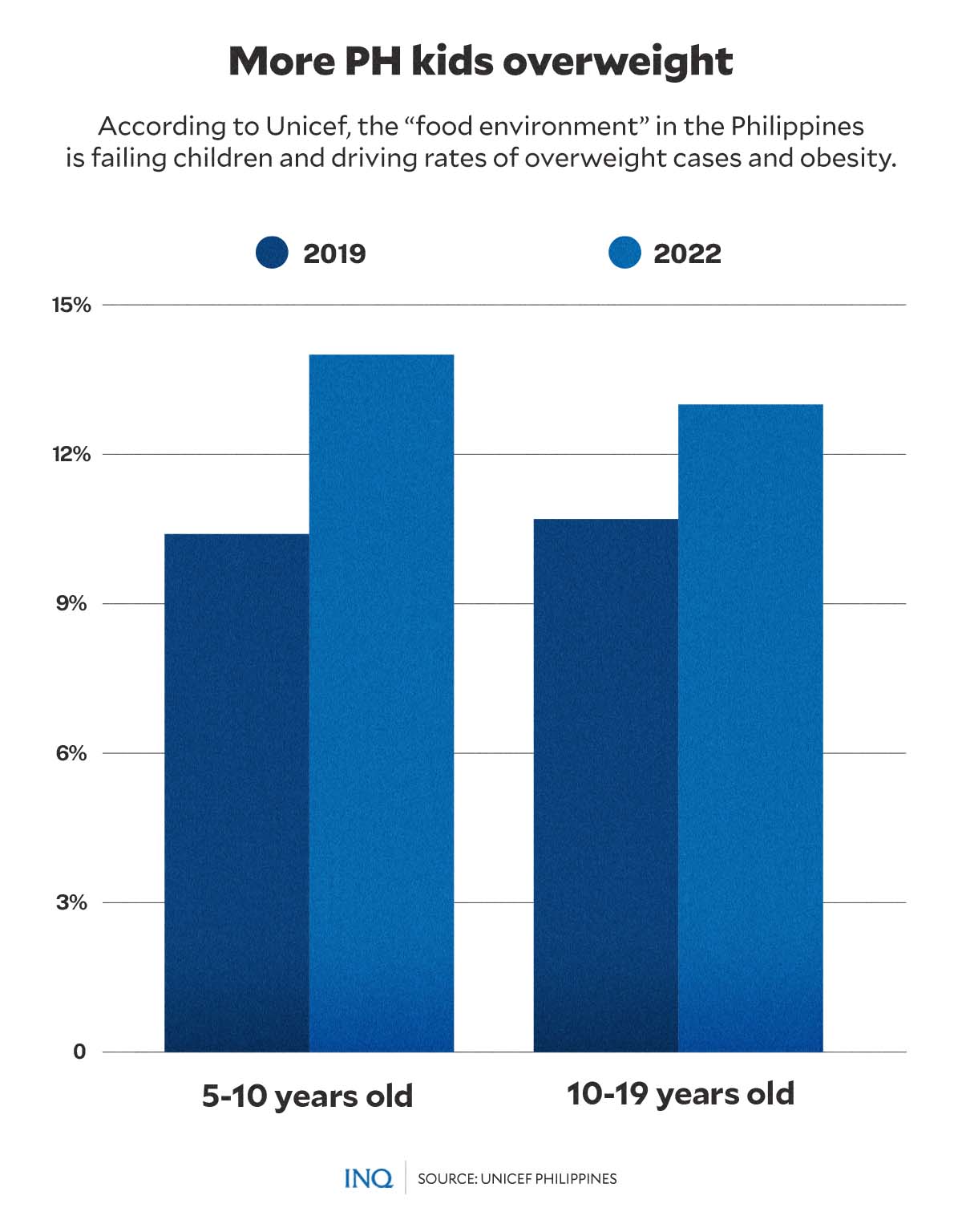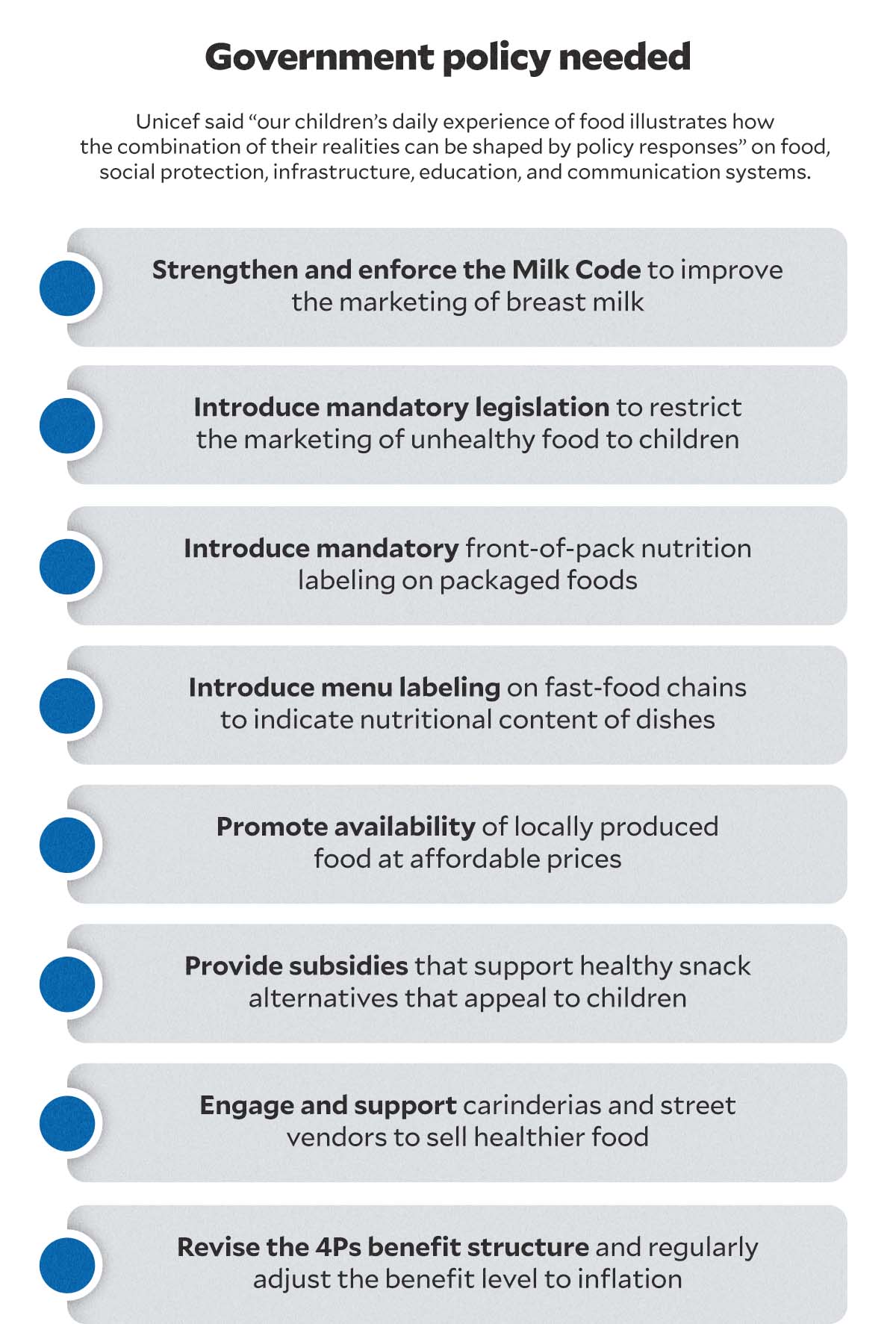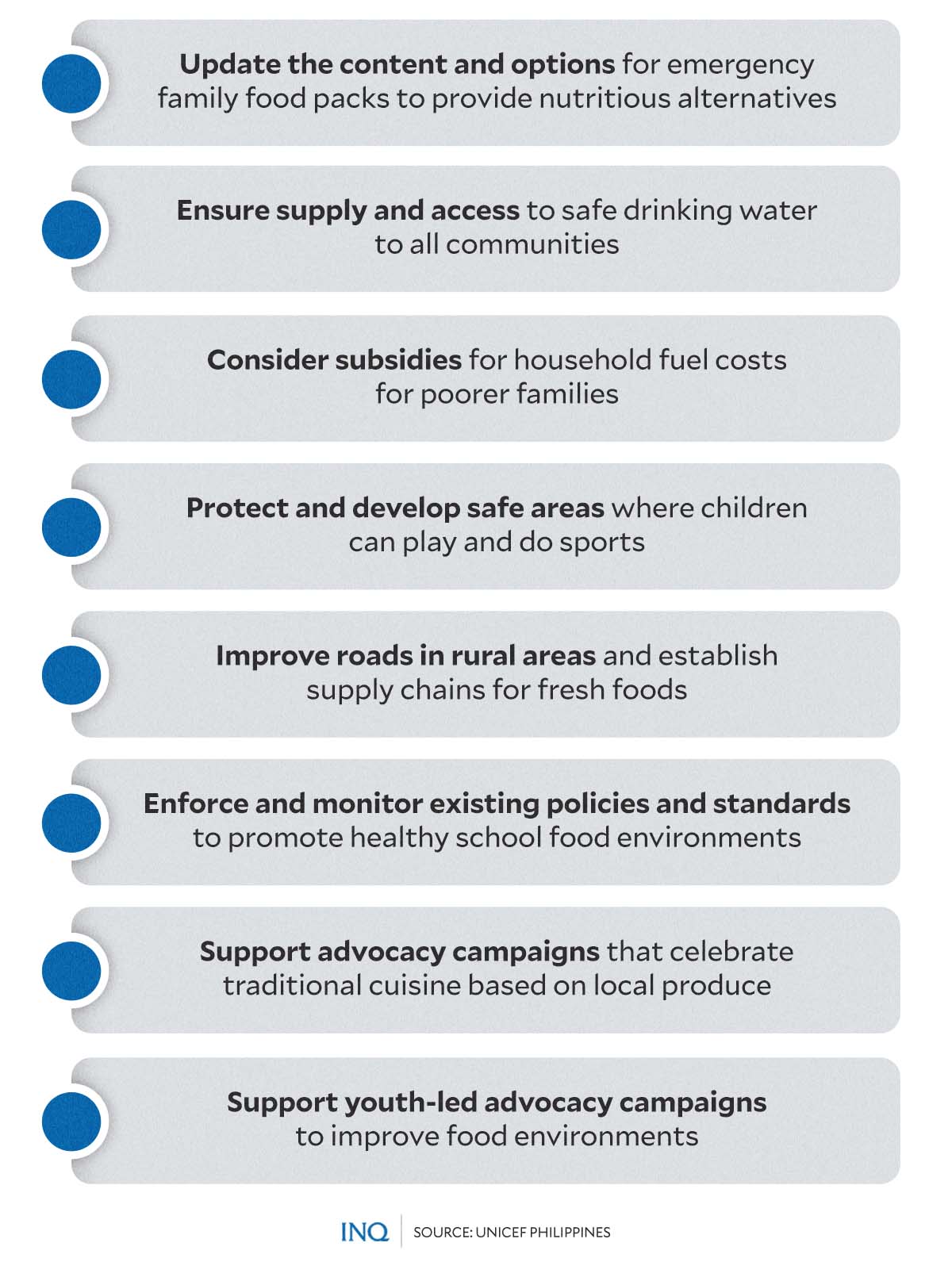Gov’t role takes spotlight as Unicef says more overweight PH kids face health nightmares
MANILA, Philippines—Children’s diets, which are shaped by the environments in which they live, are already changing—the reason that the percentage of overweight Filipino children is now significantly rising.
This was revealed by the United Nations Children’s Fund (Unicef) on Wednesday (March 8) as it published the findings of its latest study “Children’s Lived Experiences of the Food Environment”.
It was stated in the study, which “revealed the realities of children’s lives and how systems affect what they eat,” that “the food environment in the Philippines is failing children and driving the high prevalence of overweight and obesity.”
Based on data released by Unicef, overweight rates among children 5 to 10 years old and 10 to 19 years old increased significantly in 2022 compared to 2019—from 10.4 percent to 14 percent and from 10.7 percent to 13 percent, respectively.
Oyunsaikhan Dendevnorov, representative of Unicef Philippines, said “malnutrition is a serious violation of a child’s right to adequate nutrition and can have serious long-term consequences for a child’s health, development, and well-being.”
Article continues after this advertisement“Children need a varied and nutritious diet for their growth and development, and caregivers need support to provide their children with a healthy diet,” Dendevnorov said.
Article continues after this advertisementConsistent with gov’t data
The latest findings based on data collected in five study areas are consistent with what the Department of Science and Technology-Food and Nutrition Research Institute (DOST-FNRI) released last year.
READ: Obesity’s heavy toll: Millions of Filipinos now at greater health risks
The DOST-FNRI said there were 27 million overweight or obese Filipinos in 2021, with 0 to 19-year olds (3.6 million), 20 to 59-year olds (20.8 million), and those 60 years and older (2.6 million) comprising 13.33 percent, 77.04 percent, and 9.63 percent.
The result of the 2021 Expanded National Nutrition Survey showed that 14 percent of children 5 to 10 years old and 13 percent of individuals 10 to 19 years old were obese, higher compared to 7.6 percent and 10.7 percent, respectively, in 2018.
When it comes to children younger than 5 years old, the prevalence of obesity, which is the “complex condition that involves an excessive amount of body fat,” was 6.2 percent in 2021, slightly higher than 4 percent in 2018.
RELATED STORY: More Filipinos got obese during pandemic – survey
According to DOST-FNRI, because of the high obesity incidence, the Philippines missed its target of “no increase or reduced obesity prevalence” that was stated in the Philippine Plan for Action 2017 to 2022.
The World Health Organization said all over the world, obesity affects 800 million individuals, placing them more at risk for cardiovascular disease, diabetes, and some cancers.
Poor diet
Unicef stressed last year that “everyone needs to act to curb obesity,” which is now a rising health problem even in low- and middle- income countries, including the Philippines.
It said “if no action is taken, overall rates of overweight and obesity will continue to rise” and that “it is projected that more than 30 percent of Filipino adolescents will be overweight and obese by 2030.”
Based on the latest study conducted by the Unicef, children and young people in the Philippines are influenced by similar environmental factors that impact their food choices and eating habits.
“The diets of Filipino children are changing,” it said as it stressed that currently, children are eating fewer fruits and vegetables, and more sugary, salty and fatty products.
According to the Unicef, 74 percent of children 13 to 15 years old eat less than three portions of vegetables a day, while more than one third, or 38 percent, drink at least one soft drink a day.
READ: There’s more to obesity than meets the eye
“Poor diets are contributing to a triple burden of malnutrition with undernutrition, in the form of poor growth and micronutrient deficiencies, co-existing with increasing rates of overweight,” it said.
Closer look
But as stressed by Unicef, “this triple burden of malnutrition is being driven by systems that are failing to provide children with adequate diets, space to play and exercise, access to safe water and hygienic environments, and financial security.”
“The combined effects of the COVID-19 pandemic, climate change and economic recession are intensifying these systemic failings, with rising food, fertilizer, and fuel prices hitting poor families particularly hard.”
Take the case of 15-year-old Ana, who usually prepares instant noodles for her siblings when their mother is not yet home. Ana is one of the four child profiles developed by Unicef based on information collected.
It likewise developed the profile of Bea, a nine-month-old infant living with her parents and two siblings. She sometimes receives a 7-peso cake bar with cream filling as a treat. Often, she also eats processed sausage.
“These processed packaged foods are cheap, readily available and easy to prepare so are particularly attractive to poor families,” Unicef said. “However, many packaged foods contain high quantities of unhealthy fats, sugar and salt.”
By examining the children’s lived experiences, Unicef said it was able to pinpoint the policies that the Philippine government and other stakeholders need to strengthen to provide children with better access to healthier diets and living conditions.
“These improvements are crucial in supporting the growth and development of children in the country.”
Unicef said “what became clear was that children of all ages from different parts of the Philippines experience some of the same features in their environments that affect what, when, where and why they eat the foods that they do.”
Filling the gaps
It said children’s daily experience of food illustrates how the combination of their realities can be shaped by policy responses in food, social protection, infrastructure, education, and communication systems.
RELATED STORY: A public health concern
It was stressed by Unicef that these policy responses, which cut across the whole of government, “have implications for multiple systems and involve multiple stakeholders.”
- Strengthen and enforce the Milk Code to restrict the marketing of breast milk substitutes
Food and beverage companies “exploit” the natural instincts of families to provide the very best care for their growing children, with the Unicef saying that “it is easy to get swayed by labels saying that breast milk substitutes will help a child grow stronger.”
- Introduce legislation to restrict the marketing of unhealthy food to children
It said most of these advertisements are for products that are not healthy: “Children are not necessarily aware that marketing is being directed at them and that the impact is to heighten the appeal for children of largely unhealthy food and snacks.”
- Introduce mandatory front-of-pack nutrition labeling on packaged foods
“Front-of-pack nutrition labels that warn of the excessive content of unhealthy ingredients can help children and their families to make healthier choices,” Unicef stressed.
- Introduce menu labeling on fast-food chains to indicate nutritional content of dishes
The attraction of fast-food restaurants offering cheap food and drink often draws poor families who have limited cash, so clear nutrition labeling on menus can help these families to make healthier food choices.
- Promote availability of locally produced food at affordable prices
“Ensuring that fresh food markets remain open and able to sell locally produced food at affordable prices means that poor families continue to be able to access an essential source of healthy food,” Unicef said.
- Provide subsidies that support healthy snack alternatives that appeal to children
It was stressed that it is important to increase the quantity and choice of healthier snacks on the market which appeal and are affordable for children, so there should be a provision of subsidies for healthy snack alternatives to promote the manufacture, formulation and marketing of healthy snacks that are attractive for children.
- Engage and support carinderias and street vendors to sell healthier food
Working through associations of street vendors or independent food shops can be a starting point for encouraging vendors to prepare and sell healthier ready-made foods which supports both vendors’ livelihoods and access to healthy food for poor families.
- Revise the 4Ps benefit structure and regularly adjust the benefit level to inflation
Unicef said “increasing the scope of social protection systems, such as the 4Ps, regularly updating the beneficiary registry, as well as taking account of inflation and the cost of a nutritious diet, would provide an additional boost to family incomes and allow families to buy enough food and drink to cover their needs.”
- Update the content and options for emergency family food packs to provide nutritious alternatives
Many of the processed foods inside a food pack are high in salt, sugar and unhealthy fats so not suitable for long-term consumption. Unicef said in circumstances where markets are still operating, alternative options, such as supplementing the food packs with fresh food and providing emergency cash assistance should be considered.
- Ensure supply and access to safe drinking water to all communities
“Lack of access to clean water in the house not only compromises hygiene but also carries both a time and financial cost. Access to clean water at affordable prices is essential,” Unicef said.
The rest of the proposals listed by the Unicef include the provision of subsidies for household fuel costs for poorer families, protection and development of safe areas where children can play and do sports, and improve roads in rural areas and establish supply chains for fresh foods.





